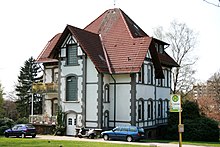Clinic Bergisch-Land
The clinic Bergisch Land , formerly Bergische folk and sanatorium Ronsdorf , is a specialist hospital that the follow-up and follow-up treatment in the field of oncology and uro-oncological diseases specializes. She belongs to the Helios group . The clinic is located in the Bergisch city of Wuppertal , in the west of the Ronsdorf district in the Blutfinke residential area near the village of Holthausen .
history
At the end of the 19th century, the “Bergische Verein für Gemeinwohl” (Bergische Verein für Gemeinwohl) sought to build a lung sanatorium for people suffering from tuberculosis and consumption in Ronsdorf under the name “Bergische Volksheilstätte”. On October 6, 1898, the decision of the town council to participate in the project was made by the town council of Ronsdorf. A block-shaped hospital building was built near Im Saalscheid .
The hospital was inaugurated on September 16, 1901; the opening with 131 beds took place on November 26, 1901. As early as 1908 the lung sanatorium was sold for 755,000 marks to the state insurance institute Rheinprovinz , the installation of the first X-ray machine took place in 1911. The senior physician Dr. Bredow took over the management of the clinic on October 11, 1914. As a building of considerable regional importance, numerous postcards with images of the building were published after the turn of the century .
In 1931 it was converted into a forest sanatorium for women in need of relaxation and at risk of tuberculosis . Due to Brüning's emergency ordinance, the lung sanatorium was closed in 1932 and converted into a maternal rest home of the National Socialist People's Welfare in 1934 , which was closed again in 1936. In March 1938, the State Insurance Institution of the Rhine Province took over the clinic again and set up a military hospital there under the name “Wuppertal-Ronsdorf Municipal Aid Hospital ”. 152 beds were still intended for tuberculosis patients. The west wing was destroyed in the air raids on Wuppertal on May 30, 1943.
From March 15, 1947, the senior medical officer Dr. Overrath took over the management of the lung sanatorium and held the office until 1974. Long after the end of the Second World War , the "Ronsdorfer Lungenheilstätte" was used as a sanatorium for the treatment of lung diseases. In March 1960, a sanatorium with a work-physiological examination department was set up on the site for better reintegration of cardiovascular injuries; this part of the building was planned by the architect Preusser in 1958. From 1974 to 1984 Professor Dr. Rolf Schmutzler took over the management of the sanatorium.
On October 4, 1975, now again under the sponsorship of the LVA Rheinprovinz (today Deutsche Rentenversicherung Rheinland ), the slated and half-timbered main building was demolished. As a replacement, today's new concrete wing was built between 1973 and 1975 under the LVA's head building director, Hans Hoischen , with 250 beds. The topping-out ceremony for this part of the building was celebrated on December 8, 1973. The basement and clockwork of the old building are still preserved. Rehabilitation and tumor aftercare became the new treatment areas at LVA-Klinik Bergisch Land .
After a restructuring process in the area of the LVA Rheinland, the main building came to Helios Kliniken GmbH in 2000 and has been part of Vamed since 2018 .
Furnishing
In the clinic, patients suffering from certain tumor types are treated as part of the aftercare. The house has 211 patient beds. Other facilities include a cafeteria , a gym , a swimming pool and a mini golf course in the park area.
On a part of the clinic site where the nurses' home was previously, the new building of the imbr - Institute for med. vocational rehabilitation with 60 patient rooms. This institute was sponsored by bit gGmbH , a non-profit company that belongs to the Oberhausen vocational support organization and works in cooperation with the service providers in the field of medical-vocational rehabilitation for people who are currently unable to work and who are to be reintegrated into working life.
Surroundings
The clinic's premises are surrounded by an extensive park; In front of the main building there is a pond that dominates the park area . The facilities go directly into the adjoining forest area, in which there are some marked hiking trails. The Saalbach rises in the immediate vicinity and feeds the nearby Ronsdorf dam and is a tributary of the Gelpe , which forms the historic Gelpe valley with its at least rudimentary water hammers , kotten and ponds . On the banks of the fire water pond is that of the sculptor Will howler from stainless steel created plastic "Tripartite Raumrhythmisierung".
The connection to local public transport is provided by an hourly city bus with the center of Ronsdorf and other bus routes.
Web links
- Proof of establishment
- Web presence of the Bergisch-Land Rehabilitation Clinic at Vamed
- Bit gGmbH website
Individual evidence
- ^ A b Ruth Meyer-Kahrweg : Architects, civil engineers, builders, property developers and their buildings in Wuppertal. Pies, Wuppertal 2003, ISBN 3-928441-52-3 .
- ↑ Fresenius transfers inpatient rehab business from Fresenius Helios to Fresenius Vamed. In: helios-gesundheit.de. Retrieved June 30, 2019 .
Coordinates: 51 ° 13 ′ 30.6 ″ N , 7 ° 10 ′ 28.5 ″ E




